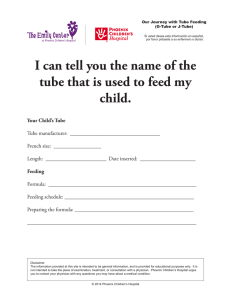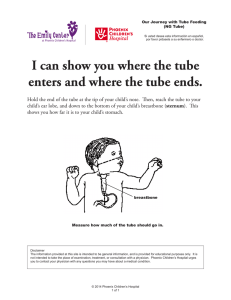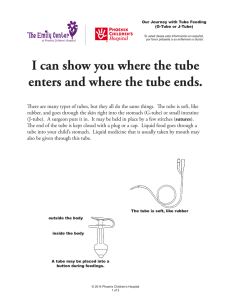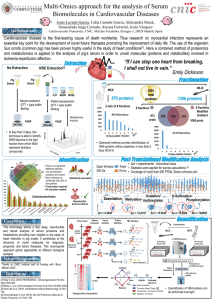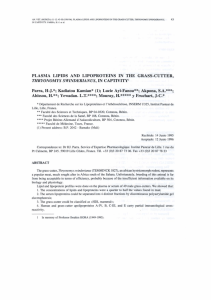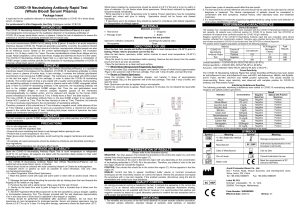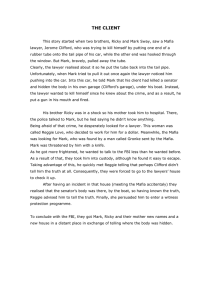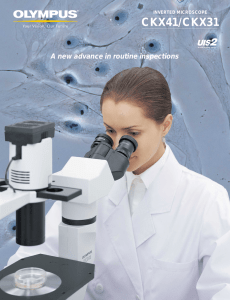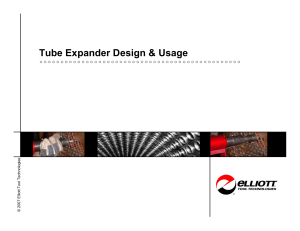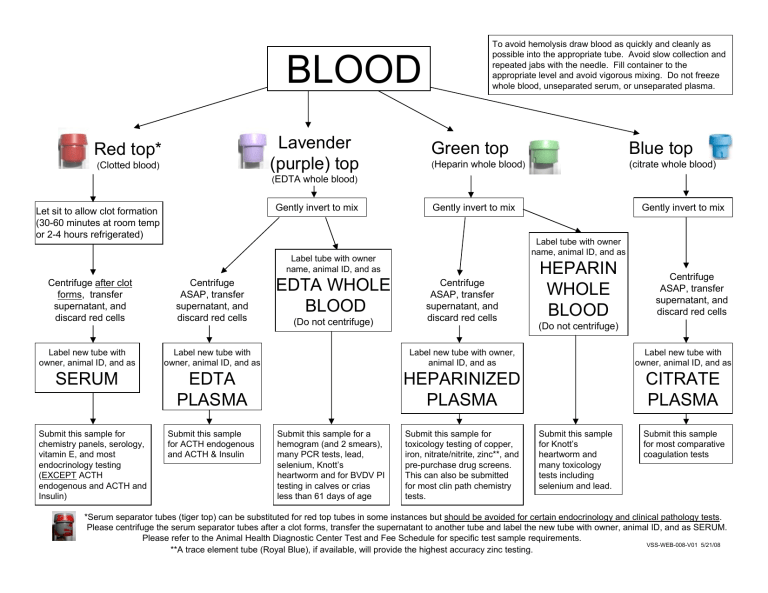
BLOOD Lavender (purple) top Red top* (Clotted blood) To avoid hemolysis draw blood as quickly and cleanly as possible into the appropriate tube. Avoid slow collection and repeated jabs with the needle. Fill container to the appropriate level and avoid vigorous mixing. Do not freeze whole blood, unseparated serum, or unseparated plasma. Green top Blue top (Heparin whole blood) (citrate whole blood) (EDTA whole blood) Gently invert to mix Let sit to allow clot formation (30-60 minutes at room temp or 2-4 hours refrigerated) Gently invert to mix Label tube with owner name, animal ID, and as Label tube with owner name, animal ID, and as Centrifuge after clot forms, transfer supernatant, and discard red cells Label new tube with owner, animal ID, and as SERUM Submit this sample for chemistry panels, serology, vitamin E, and most endocrinology testing (EXCEPT ACTH endogenous and ACTH and Insulin) Centrifuge ASAP, transfer supernatant, and discard red cells EDTA WHOLE BLOOD (Do not centrifuge) Label new tube with owner, animal ID, and as Centrifuge ASAP, transfer supernatant, and discard red cells HEPARIN WHOLE BLOOD Label new tube with owner, animal ID, and as HEPARINIZED PLASMA Submit this sample for a hemogram (and 2 smears), many PCR tests, lead, selenium, Knott’s heartworm and for BVDV PI testing in calves or crias less than 61 days of age Submit this sample for toxicology testing of copper, iron, nitrate/nitrite, zinc**, and pre-purchase drug screens. This can also be submitted for most clin path chemistry tests. Centrifuge ASAP, transfer supernatant, and discard red cells (Do not centrifuge) Label new tube with owner, animal ID, and as EDTA PLASMA Submit this sample for ACTH endogenous and ACTH & Insulin Gently invert to mix CITRATE PLASMA Submit this sample for Knott’s heartworm and many toxicology tests including selenium and lead. Submit this sample for most comparative coagulation tests *Serum separator tubes (tiger top) can be substituted for red top tubes in some instances but should be avoided for certain endocrinology and clinical pathology tests. Please centrifuge the serum separator tubes after a clot forms, transfer the supernatant to another tube and label the new tube with owner, animal ID, and as SERUM. Please refer to the Animal Health Diagnostic Center Test and Fee Schedule for specific test sample requirements. VSS-WEB-008-V01 5/21/08 **A trace element tube (Royal Blue), if available, will provide the highest accuracy zinc testing. Hematology Fact Sheet In order to expedite processing and increase the accuracy of testing performed it is critical that after separating serum or plasma all new sample containers are labeled with owner name, animal ID, and type of specimen submitted (i.e., serum, EDTA plasma, heparinized plasma, or citrate plasma) Hemolysis and Lipemia To avoid hemolysis draw blood as quickly and cleanly as possible into the appropriate tube. Avoid slow collection and repeated jabs with the needle. It is best to avoid forcing blood from a syringe through a small needle into a collection tube as cells may be ruptured. Fill container to the appropriate level and avoid vigorous mixing. Do not freeze serum prior to separating from the clot. If practical, samples should be obtained from a fasting animal to reduce the degree of lipemia. Whole Blood This generally refers to unclotted whole blood and is further clarified by the type of anticoagulant used in the collection tube. Whole blood should not be frozen. EDTA whole blood = Lavender (purple) top tube Label this tube with owner name, animal ID, and as EDTA whole blood. This tube (plus 2 blood smears) should be submitted for a hemogram without separation or freezing but should be kept cool. Also this sample is required if a blood sample is being used for detection of BVDV persistently infected calves or crias less than 61 days of age. This sample is also used for Knott’s heartworm, whole blood selenium, lead, and canine and feline blood typing. Heparin whole blood = Green top tube Label this tube with owner name, animal ID, and as heparin whole blood. This tube without separation is appropriate for Knott’s heartworm and whole blood toxicology testing of many agents including selenium, lead, and drug screens*. Serum This is the supernatant that is removed after a clot has formed and centrifugation of blood collected in a red top tube (see note #3 below about serum separator tubes). It is advised that if possible serum should be separated from the cells and put into a separate container. The approximate yield of serum from a 10 ml red top tube that is completely filled from a well hydrated animal is 5 ml. For certain tests in clinical pathology and endocrinology the serum must be separated or test results are inaccurate. This new container needs be labeled with the owner name, animal ID, and the word “serum”. This serum should be kept cool. Plasma This is the fluid that is removed after centrifugation of anticoagulated whole blood. The exact nature of the plasma depends on which anticoagulant is used: EDTA plasma This is the supernatant that is removed after centrifugation of blood collected in a lavender (purple) top tube. This sample should be labeled with the owner name, animal ID, and the words “EDTA plasma”. This is the sample needed for ACTH endogenous and ACTH & insulin. For these tests the plasma should be separated immediately after collection, transferred to a plastic container and frozen immediately**. Heparinized plasma This is the supernatant that is removed after centrifugation of blood collected in a green top tube. This sample should be labeled with the owner name, animal ID, and the words “heparinized plasma”. This sample should be kept cool. This sample can be submitted for many toxicology tests including copper, iron, nitrate/nitrite, zinc, and pre-purchase drug screens. Also this sample can be submitted for most clinical pathology chemistry tests. Citrate plasma This is the supernatant that is removed after centrifugation of blood collected in a light blue top tube. This sample should be labeled with the owner name, animal ID, and the words “citrate plasma”. This sample should be kept cool and can be submitted for most comparative coagulation tests (other than blood typing)***. Additional information A trace element tube (Royal blue top) is recommended for zinc testing. If trace element tubes are unavailable then blood to be submitted for zinc testing should be collected and stored in such a manner as to not come into contact with any rubber surfaces. * Please consult the AHDC test and fee schedule for verification of requirements for individual tests. **Please consult Appendix C of the AHDC test and fee schedule for complete submission guidelines for endocrinology tests. ***Please consult Appendix D of the AHDC test and fee schedule for complete submission guidelines for comparative coagulation tests. Serum is the sample of choice for chemistry, serology, immunology, vitamin E, and most endocrinology testing. Many tests are validated using serum rather than plasma and therefore only serum will be accepted for these tests*. Additional notes: 1) For cross match or compatibility testing both serum and EDTA whole blood must be submitted from each donor and recipient. 2) Serum is not accepted for ACTH endogenous and the ACTH & Insulin tests. Only EDTA plasma is accepted (see below). 3) Serum separator tubes (Tiger top) can be substituted for red top tubes in some instances but should be avoided for certain endocrinology and clinical pathology tests such as a progesterone baseline, thyroid panels, cortisol tests and certain drug levels. It is recommended that these tubes are centrifuged after the clot forms and the serum transferred to a separate container. This new container should be labeled with owner name, animal ID, and as serum. 4) Toxoplasma gondii IHA testing is validated for serum only. DL-905 May 2008
